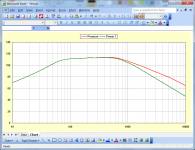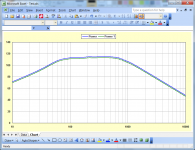The term acoustic power is not confusing if used properly. I am sad, that thou do not stick to the truth.After carefully considering all the comments posted on "acoustical power" I have decided to leave Hornresp unchanged. I appreciate that the term might be confusing to some users, but I am prepared to live with that. The acoustical power chart section of the Help file may be amended in due course if I can think of a better description.
.
I am sad, that thou do not stick to the truth.
Hi Uli,
I'm sorry to hear that.
In the absence of any suggested suitable alternative, it is the best that I (and the AkAbak development team it would seem) can come up with.
Kind regards,
David
I suggest calculating the following acoustic properties by default:
* Impedance
* Power level, say power in dB as referenced to 1 Picowatt.
* Pressure level
* Phase of pressure level
* Group delay of pressure level
Thanks a lot!
The default charts currently provided are considered to be the most useful.
The acoustical power level chart is scaled to display the equivalent SPL at 1 metre for that power level, rather than being referenced to 1 pW. The chart is titled "Acoustical Power (dB)" which means that it plots a power ratio or "level", not absolute acoustical power. The chart title would read "Acoustical Power (watts)" if power was directly shown.
It seems that the acoustical power discussion is starting to go round and round in circles, so it is probably a good time to call a halt - we obviously have different views on the subject, so I suggest that we just agree to disagree.
I still have problem seeing how giving power level re 1pW (or power in watts) is useful people that are not in academia, a standards committee, or working with noise sources. Acoustic power is not something you can easily measure, so it's not something you can easily get familiar with through practice. So by giving power level re 1pW, the user gets a value that does not tell him anything useful, since he cannot compare it to anything he can measure (measuring acoustic impedance, pressure, phase, group delay and displacement is possible with relatively simple means). Giving an unfamiliar value as the default chart would not, IMHO, make the learning curve of Hornresp less steep.
Perhaps David can be persuaded to include an Acoustical Power Level tool that simply scales the Acoustical Power chart to the 1pW reference - but from the discussion so far, it seems unlikely
Or the chart could give a scale factor, like the Acoustical Impedance and Displacement charts, that gives the offset from power re 1pW.
Perhaps David can be persuaded to include an Acoustical Power Level tool that simply scales the Acoustical Power chart to the 1pW reference - but from the discussion so far, it seems unlikely
Or the chart could give a scale factor, like the Acoustical Impedance and Displacement charts, that gives the offset from power re 1pW.
David, Hornresp will not stop outputting wrong results, if i do. As of now, Hornresp plots something referenced to radiation angle limit (full, half, quarter or eighth sphere). This is not acoustic power. Kolbrek, acoustic power has several practical uses, often when considering sound as obnoxious noise (thru walls or streets) or as perceived loudness (thru concert hall), because that tends to be a sum of radiated, refracted, reflected and damped pressures.
I still have problem seeing how giving power level re 1pW (or power in watts) is useful people that are not in academia, a standards committee, or working with noise sources. Acoustic power is not something you can easily measure, so it's not something you can easily get familiar with through practice. So by giving power level re 1pW, the user gets a value that does not tell him anything useful, since he cannot compare it to anything he can measure (measuring acoustic impedance, pressure, phase, group delay and displacement is possible with relatively simple means). Giving an unfamiliar value as the default chart would not, IMHO, make the learning curve of Hornresp less steep.
Perhaps David can be persuaded to include an Acoustical Power Level tool that simply scales the Acoustical Power chart to the 1pW reference - but from the discussion so far, it seems unlikely
Or the chart could give a scale factor, like the Acoustical Impedance and Displacement charts, that gives the offset from power re 1pW.
Agreed completely.
There is very little value to adding this other than pleasing the viewpoint of one person.
A casual user does not have the ability to make useful power measurements. And even a professional would have quite a time to setup and have results that could truly be indicative of precise measurements.
I have the equipment and I have been in this business as a consultant for many years. And I have never been in the position or had the need to make a true power measurement.
For the very few ( so far one ) that require this I would think that they are as able to convert the naming conventions within Hornresp to whatever they so choose. And make the calculations to what ever unit of force or energy that they require to work with.
I believe Hornresp uses the term because the chart in question plots the frequency response of the total radiated power, which is useful to the average user, even if the actual power level is not.
I am well aware of the uses for sound power. But Hornresp is a program for loudspeaker design, not for concert hall acoustics nor for abatement of obnoxious noise (although with the small modifications suggested in my previous post, it could be).
So Uli, do you actually need the correct power level as output from Hornresp? Or is this just about having things absolutely right according to the ISO standard?
I am well aware of the uses for sound power. But Hornresp is a program for loudspeaker design, not for concert hall acoustics nor for abatement of obnoxious noise (although with the small modifications suggested in my previous post, it could be).
So Uli, do you actually need the correct power level as output from Hornresp? Or is this just about having things absolutely right according to the ISO standard?
It is about truth, which includes being able to specifiy designs with absolute values. If acoustic power was useless for us, then why does Hornresp by default plot something called like but not being that? Why not acoustic pressure? Why that mess? Simple, real standards exist.
It is about truth, which includes being able to specifiy designs with absolute values. If acoustic power was useless for us, then why does Hornresp by default plot something called like but not being that? Why not acoustic pressure? Why that mess? Simple, real standards exist.
Uli think about this:
Hornresp is a simulator. Nothing in it is absolute.
It is all best calculations derived from practical examples and experimental observations.
David has been working on this program for a very long time. And it is a very accurate program for what it does.
No one is making you use this program. It is your free choice to use it or not.
So in the end analysis of the situation the question and answer are extremely simple.
You have made a request. It has been considered. And you have an answer.
Time to drop the circular arguement. You have returned to the beginning of your arguement and you already know the answer to your request.
If acoustic power was not important, then why does Hornresp use the term? Even if roses may be not important, then do not call guns roses, because I do not want roses to be called guns.
"What’s in a name? that which we call a rose
By any other name would smell as sweet;"
William Shakespeare
1564-1616
The same for acoustical power, it is
(In "Yoda speak" just for you, Jedi "Obi-Wan Mark"
What's in a Name...
For a test single-segment horn loudspeaker:
Attachment 1 compares the pressure response (red trace) to the Hornresp-calculated power response (green trace). The Hornresp-calculated power response is obviously different to the pressure response, so to call the Hornresp-calculated power response a pressure response would simply not be correct.
Attachment 2 compares the power response referenced to 1 pW (blue trace) to the Hornresp-calculated power response (green trace). The two traces are identical in shape, so both accurately show the power response curve. (The difference between 50Hz and 100Hz is 8.7341 dB in each case, for example).
Hornresp uses a reference value different to 1 pW so that the power response curve exactly matches the pressure response curve at lower frequencies, where radiation is non-directional, as shown in Attachment 1. This enables the Hornresp-predicted response for multiple-segment low-frequency horn loudspeakers, where a pressure response curve is not available, to be directly compared against measured results.
For a test single-segment horn loudspeaker:
Attachment 1 compares the pressure response (red trace) to the Hornresp-calculated power response (green trace). The Hornresp-calculated power response is obviously different to the pressure response, so to call the Hornresp-calculated power response a pressure response would simply not be correct.
Attachment 2 compares the power response referenced to 1 pW (blue trace) to the Hornresp-calculated power response (green trace). The two traces are identical in shape, so both accurately show the power response curve. (The difference between 50Hz and 100Hz is 8.7341 dB in each case, for example).
Hornresp uses a reference value different to 1 pW so that the power response curve exactly matches the pressure response curve at lower frequencies, where radiation is non-directional, as shown in Attachment 1. This enables the Hornresp-predicted response for multiple-segment low-frequency horn loudspeakers, where a pressure response curve is not available, to be directly compared against measured results.
Attachments
They do not. If one halves radiation angle limit in Hornresp, say from full-sphere to half-sphere, then the "power" curve rises by 6dB. But power has only risen by 3dB (due to impedance doubling).Attachment 2 compares the power response referenced to 1 pW (blue trace) to the Hornresp-calculated power response (green trace). The two traces are identical in shape, so both accurately show the power response curve. (The difference between 50Hz and 100Hz is 8.7341 dB in each case, for example).
They do not. If one halves radiation angle limit in Hornresp, say from full-sphere to half-sphere, then the "power" curve rises by 6dB. But power has only risen by 3dB (due to impedance doubling).
Can you provide the hornresp record you are using so we can play along
Simulate anything, at first with full sphere radiation, at second with half sphere one, and compare: At low frequencies "power" and pressure rise with 6dB, but power does with only 3dB. At high frequencies, at which the loudspeaker beams on its own, "power" rises by 3dB, while power does not at all.
Last edited:
The change from free space to infinite baffle loading loading does naturally influence the response near low cutoff more than higher up where the horn's directivity takes over.

- Home
- Loudspeakers
- Subwoofers
- Hornresp


